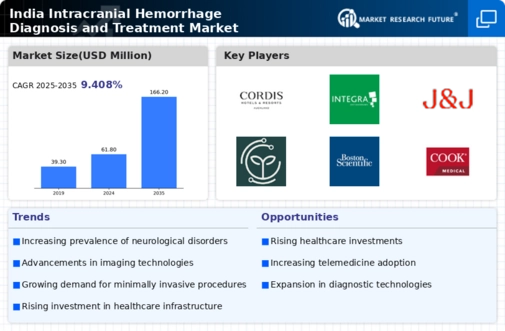Market Growth Projections
The Global India Intracranial Hemorrhage Diagnosis and Treatment Market Industry is poised for significant growth, with projections indicating a market value of 1250 USD Million in 2024, potentially reaching 2750 USD Million by 2035. This growth trajectory, characterized by a compound annual growth rate of 7.43% from 2025 to 2035, reflects the increasing demand for effective diagnosis and treatment options in response to the rising incidence of intracranial hemorrhage. The market's expansion is driven by various factors, including advancements in technology, government support, and a growing awareness of neurological health issues.
Emerging Treatment Modalities
The emergence of innovative treatment modalities, including minimally invasive surgical techniques and novel pharmacological agents, is reshaping the Global India Intracranial Hemorrhage Diagnosis and Treatment Market Industry. These advancements offer patients less invasive options with shorter recovery times, which is particularly appealing in a healthcare landscape that increasingly prioritizes patient-centered care. As these new treatments gain traction, they are likely to attract investment and research, further driving market expansion. The combination of these factors positions the market for substantial growth, aligning with the projected increase in market value to 2750 USD Million by 2035.
Rising Awareness and Education
Growing awareness about intracranial hemorrhage and its consequences is driving demand within the Global India Intracranial Hemorrhage Diagnosis and Treatment Market Industry. Educational campaigns by health organizations and government bodies are informing the public about risk factors and symptoms, leading to earlier diagnosis and treatment. Increased awareness among healthcare professionals regarding the latest treatment protocols also contributes to improved patient management. This heightened focus on education is expected to foster market growth, as more individuals seek timely medical intervention, thereby enhancing overall health outcomes.
Government Initiatives and Funding
Government initiatives aimed at improving healthcare infrastructure and access to treatment are significantly influencing the Global India Intracranial Hemorrhage Diagnosis and Treatment Market Industry. Increased funding for healthcare programs, particularly in neurology, enhances the availability of diagnostic and treatment facilities across urban and rural areas. Initiatives such as the Ayushman Bharat scheme aim to provide affordable healthcare services, thereby increasing patient access to necessary interventions. This supportive environment is likely to propel market growth, with a projected compound annual growth rate of 7.43% from 2025 to 2035, reflecting the government's commitment to addressing neurological disorders.
Advancements in Diagnostic Technologies
Technological advancements in imaging modalities, such as CT and MRI, are transforming the landscape of the Global India Intracranial Hemorrhage Diagnosis and Treatment Market Industry. Enhanced imaging techniques facilitate early and accurate diagnosis, which is crucial for effective treatment planning. The integration of artificial intelligence in imaging analysis further streamlines the diagnostic process, potentially reducing time to diagnosis. As the market evolves, these innovations are expected to drive growth, with projections indicating a market value of 2750 USD Million by 2035, underscoring the importance of cutting-edge technology in improving patient outcomes.
Increasing Incidence of Intracranial Hemorrhage
The rising incidence of intracranial hemorrhage in India is a pivotal driver for the Global India Intracranial Hemorrhage Diagnosis and Treatment Market Industry. Factors such as urbanization, lifestyle changes, and an aging population contribute to this trend. Reports indicate that the prevalence of stroke-related intracranial hemorrhage is on the rise, leading to a heightened demand for diagnostic and therapeutic interventions. As of 2024, the market is valued at approximately 1250 USD Million, reflecting the urgent need for effective treatment options and advanced diagnostic technologies to manage this growing health concern.











